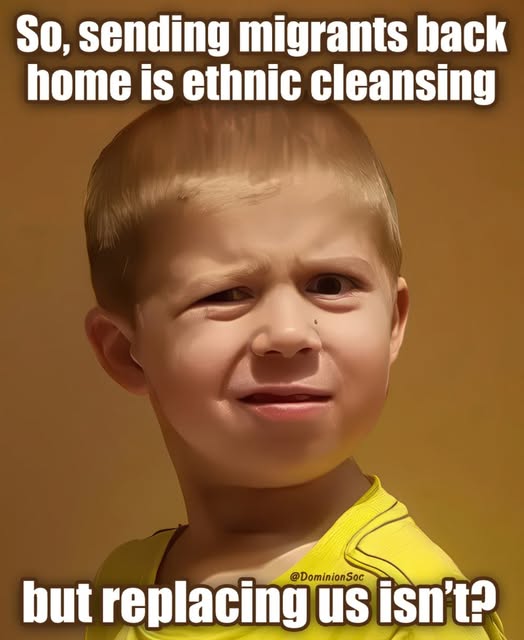WHAT REMAINS?: Exposing the Kamloops Mass Grave Deception’s Impact on Powell River
This feature length investigative documentary, about the aftermath of the Kamloops mass grave deception, was produced by Simon Hergott and Frances Widdowson. The backdrop is the March 30 talk that Frances Widdowson gave in Powell River about “Uncovering the Grave Error at Kamloops and its Relationship to the [Powell River] Name Change and …
www.youtube.com
| Forwarded this email? Subscribe here for morePope Leo Wants More Muslims In The WestThe Vatican endorses the most fundamental betrayal of Christian nations.John ZmirakDec 11 ∙ Preview ∙ Guest post READ IN APP My newsletteris the #1 conservative blog on Substack — recommended by over 312 other Substack authors.Get 20% off now to celebrate the 2024 election! Get 20% off for 1 yearWelcome to the fourth article in our new section on religion: Christian Nation.When Pope Leo XIV was elected, I realized what was happening. Pope Francis had been too radical, too overtly Marxist, too crass. He kept doing friendly interviews with atheists, defending sexual predators, and making deals with the Chinese Communist organ thieves. He turned the stove up too high, so the frogs began to realize that they were getting boiled. Even the mediocre, faithless Globalist cardinals with whom he’d stacked the electorate realized that they couldn’t impose another low-IQ Third World sociopath on the throne — lest Americans cut off the finances which are the lifeblood of the Vatican.Instead they would elect an actual American! Yes, they’d install a candidate who rose through the ranks in the Chicago machine built by Saul Alinsky ally Cardinal Joseph Bernardin — the man who invented the “Seamless Garment” as a g-string for pro-abortion Democrats with Irish and Italian last names. The new pope would soft-pedal the socialism, the ecological madness — even the LGBTQMYNAMEISLEGION advocacy that was irking the Americans — as long as he stayed true to the one essential program that advanced the Globalist goal: opening the borders of every Western country to conquest by Third World immigrants… |
| WestThe Vatican endorses the most fundamental betrayal of Christian nations.John ZmirakDec 11 ∙ Preview ∙ Guest post When Pope Leo XIV was elected, I realized what was happening. Pope Francis had been too radical, too overtly Marxist, too crass. He kept doing friendly interviews with atheists, defending sexual predators, and making deals with the Chinese Communist organ thieves. He turned the stove up too high, so the frogs began to realize that they were getting boiled. Even the mediocre, faithless Globalist cardinals with whom he’d stacked the electorate realized that they couldn’t impose another low-IQ Third World sociopath on the throne — lest Americans cut off the finances which are the lifeblood of the Vatican.Instead they would elect an actual American! Yes, they’d install a candidate who rose through the ranks in the Chicago machine built by Saul Alinsky ally Cardinal Joseph Bernardin — the man who invented the “Seamless Garment” as a g-string for pro-abortion Democrats with Irish and Italian last names. The new pope would soft-pedal the socialism, the ecological madness — even the LGBTQMYNAMEISLEGION advocacy that was irking the Americans — as long as he stayed true to the one essential program that advanced the Globalist goal: opening the borders of every Western country to conquest by Third World immigrants… |
Making a Killing: FULL DOCUMENTARY FILM
OneBC Caucus is proud to present Making a Killing: Reconciliation, Genocide, and Plunder in Canada.
Making a Killing is a feature documentary film exposing the massive scandal behind the taking of wealth, land, and power from the Canadian public to benefit indigenous tribes.
It debunks one of the worst lies in Canadian history: the lie that 215 bodies were found at the Kamloops Residential School and that Canadians committed a mass murder against indigenous children. Making a Killing is the first documentary film produced by an elected caucus.
DEMONIZATION OF WHITES
https://www.facebook.com/share/v/17sjmhkiyf/
While the British Columbia provincial NDP divides Canadians between indigenous and non-indigenous, OneBC believes in unity. We’re ALL Canadian and only Canadian, with equal rights and no special privileges.

This NDP government has been stopping economic development with the justification of First Nations people when their own policies are hurting the First Nations community.
We need prosperity for all not poverty for all, but the NDP thinks that everything will be better if we are all equally poor.





